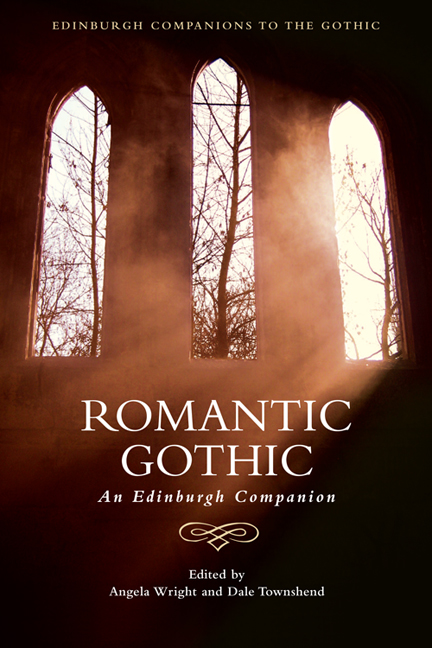1 - Gothic and Romantic: An Historical Overview
Published online by Cambridge University Press: 05 August 2016
Summary
Romantic Gothic: for some, the title of this volume of essays might read as oxymoronic, if not overtly confrontational. That is, despite the critical attention that, since the late 1960s, the relationship between ‘Gothic’ writing of the late eighteenth and early nineteenth centuries and the ‘Romantic’ aesthetics with which they were contemporary has received, we might still be inclined to think of the ‘Gothic’ and the ‘Romantic’ as two oppositional, even mutually exclusive modes. Indeed, of all the taxonomic distinctions that structure our negotiation of literary history and canonicity, it would seem that those between the ‘Romantic’ and the ‘Gothic’, though by no means uncontested, are some of the most inveterate. For many cultural commentators over the past two centuries, the phrase ‘Romantic Gothic’ might be accused of yoking together, as if by a certain violence, two utterly heterogeneous modes.
Despite the fact that ‘Romantic’ and ‘Gothic’ are both literary terms that were retrospectively annexed to the forms that they inhabit, it seems relatively easy, at first glance, to appreciate the differing contours of these two discrete literary strains through a brief consideration of two serendipitously linked texts: William Wordsworth's ‘Lines Written A Few Miles Above Tintern Abbey, On Revisiting the Banks of the Wye During a Tour, July 13, 1798’, the final poem included in the first edition of Wordsworth and Samuel Taylor Coleridge's collaborative but anonymously published Lyrical Ballads, With A Few Other Poems (1798), and Sophia Ziegenhirt's The Orphan of Tintern Abbey, a three-volume romance that was published by A. K. Newman at the Minerva Press, London, in 1816.
As the ‘Advertisement’ that prefaced Lyrical Ballads in 1798 made clear, Wordsworth and Coleridge's collection of poetry was to be conceived of as wholly ‘experimental’ in nature, as a new and somewhat audacious attempt at adapting the ‘language of conversation in the middle and lower classes of society’ to ‘the purposes of poetic pleasure’ (Gamer and Porter 2008: 47). Indeed, it is largely on the basis of this and other ‘democratising’ gestures, both formal and political, to be found across the collection that the publication of Lyrical Ballads in 1798 is still, today, often hailed as the moment of inauguration for the Romantic ‘school’ or ‘movement’ in Britain.
- Type
- Chapter
- Information
- Romantic GothicAn Edinburgh Companion, pp. 1 - 34Publisher: Edinburgh University PressPrint publication year: 2015



